Key Points
- The swamp territory of Louisiana is the perfect habitat for many snake species.
- Venomous and nonvenomous snakes live in Louisiana.
- Rattlesnakes in the state include the timber rattlesnake, the western pygmy rattlesnake, and the eastern diamondback rattlesnake.
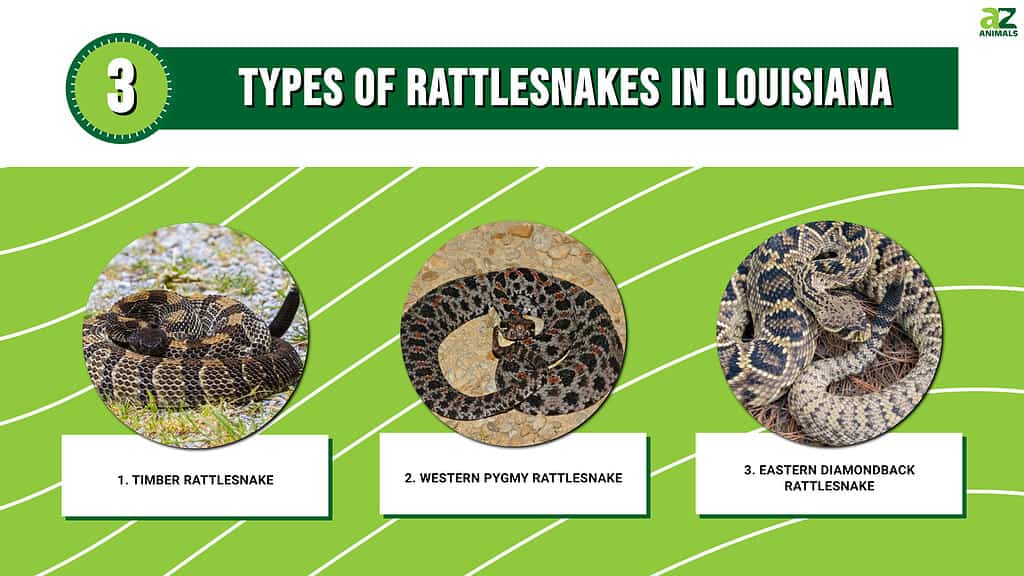
Wherever there are swamps, there are also snakes—and Louisiana has plenty of both. There are at least 48 different species of snakes living in the state of Louisiana, ranging from the brightly colored Northern Scarlet Snake to the venomous Cottonmouth Snake. Whether venomous or non-venomous, however, all snakes are vital to maintaining a balanced ecosystem. Most snakes are not overly aggressive, and they will leave you alone if you leave them alone. Of course, it is always best to respect any snake you see in the wild. There are seven venomous snakes in Louisiana, and three of these are rattlesnake species. Let’s take a closer look at the 3 types of rattlesnakes in Louisiana.
1. Timber Rattlesnake

Bites from timber rattlesnakes can cause seizures, severe shock, and comas.
©Frode Jacobsen/Shutterstock.com
| Timber Rattlesnake | |
|---|---|
| Range | All of Louisiana |
| Length | 36-60 inches |
| Lifespan | 30+ years |
The Timber Rattlesnake lives all throughout Louisiana. However, it is not as common in southwestern Louisiana or along the coastline. These snakes often live in farming fields, swamps and marshes, forests, or floodplains, tree hollows, and even sugar cane fields. When the timber rattlesnake is found in areas with sugar cane fields, it is often called a Canebrake Rattlesnake instead. These snakes eat small mammals like rats and mice and can also climb high trees as tall as 80 feet to hunt birds.
Timber rattlesnakes are the most common rattlesnake in Louisiana, and they are also by far the most dangerous. However, they are not known to be highly aggressive and will give you plenty of warning by shaking their rattles loudly before any aggressive attacks. Timber rattlesnakes are typically 4-5 feet long and weigh 5-10 pounds. They have very long fangs and can inject a lot of venom when they bite. Bites from timber rattlesnakes can cause seizures, severe shock, and comas. Their venom can also cause severe internal bleeding, tissue damage, and, if left untreated for too long, can result in blood infections and gangrene.
While timber rattlesnakes come in various colors, they are often grey with pink undertones, light gray, tan, or darker brown. They have a clear Chevron-type pattern that runs along the length of their bodies down to the tip of their tails. Timber rattlesnakes also have a distinct black, brown, pink, or orange-colored stripe along the middle of their backs. There are some timber rattlesnakes in Louisiana that are much darker in color and may be so dark that they look almost completely black.
2. Western Pygmy Rattlesnake
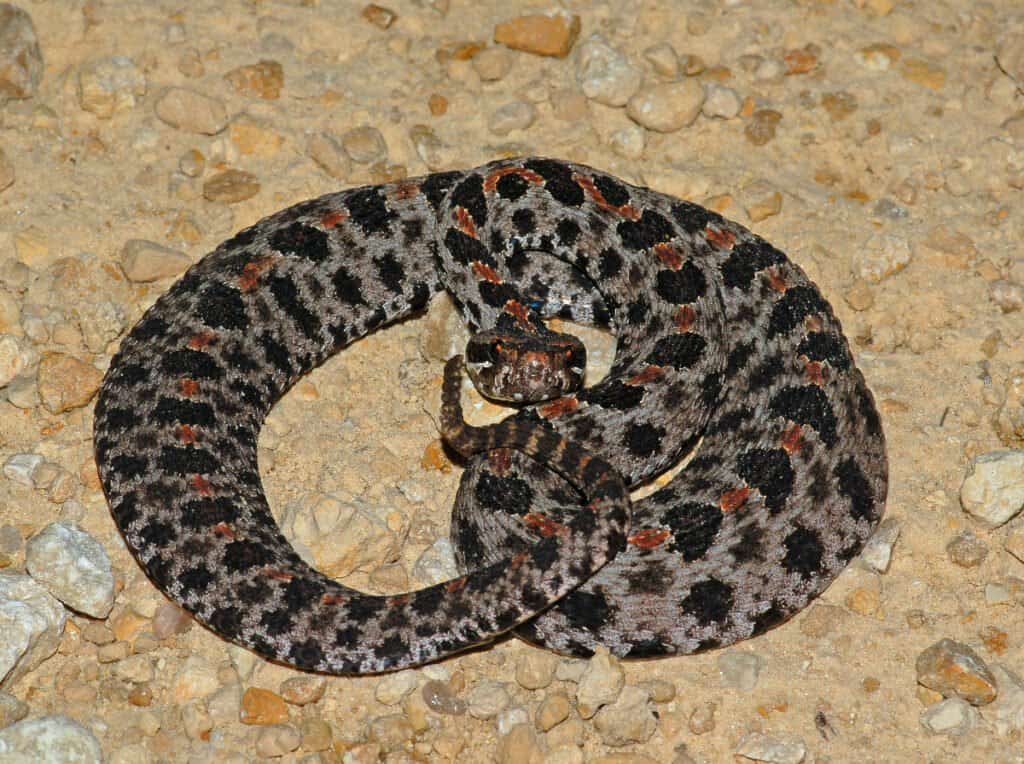
The Western Pygmy Rattlesnake has a small rattle that sounds like buzzing insects.
©Gerald A. DeBoer/Shutterstock.com
| Western Pygmy Rattlesnake | |
|---|---|
| Range | Mostly in Western Louisiana |
| Length | 16-25 inches |
| Lifespan | 20+ years |
Like its name, the Western Pygmy Rattlesnake is a smaller snake that is scattered throughout the state of Louisiana. Over time these snakes have become increasingly uncommon throughout the state, and now they are mainly found in the western portions of Louisiana, except along the western edges of the Mississippi River and along the coast.
Western pygmy rattlesnakes are the smallest venomous snake in Louisiana, measuring about 15 inches on average, although they can grow between 16 and 25 inches long. These snakes have a striking appearance, with dark spots along the top and sides of their gray or silver bodies. Some of the pygmy rattlesnakes in Louisiana also have a rust-colored stripe running vertically down the middle of their backs, while others do not. Western pygmy rattlesnakes have a black stripe around their eyes running down to their mouth.
Pygmy rattlesnakes have cytotoxic venom. However, because they are smaller rattlesnakes, they do inject a lot of venom when they bite. Despite their small size and this low venom yield, however, being bitten by a western pygmy rattlesnake can disrupt your blood flow, prevent blood clotting, and destroy tissue.
3. Eastern Diamondback Rattlesnake

Although not as aggressive as the western diamondback rattlesnake, eastern diamondback rattlesnakes are still a force to be reckoned with.
©Chase D’animulls/Shutterstock.com
| Eastern Diamondback Rattlesnake | |
|---|---|
| Range | Southeastern Louisiana |
| Length | 36-72 inches |
| Lifespan | 15-20 years |
The Eastern Diamondback Rattlesnake lives in southeastern Louisiana. These snakes prefer moist, forested areas. They are excellent swimmers and can easily climb 30-foot-tall trees. Eastern diamondback rattlesnakes spend early mornings and afternoons basking in the sun, and then later take refuge in gopher tortoise burrows. Measuring 3-6 feet in length and weighing 5-10 pounds, the eastern diamondback rattlesnake is one of the largest and heaviest rattlesnakes in the Americas. There are reports of some of these snakes reaching nearly 8 feet in length!
Eastern diamondback rattlesnakes are yellowish, olive green, or gray, tinged with brown undertones. They get their name from the large dark patterns on their backs. These patterns are shaped like dark diamonds with light-colored borders and light-brown centers. A thick, dark-colored band bordered with white stretches from each eye to the mouth on both sides of their face.
Although not as aggressive as the western diamondback rattlesnake, eastern diamondback rattlesnakes are still a force to be reckoned with. Because of their large size, they can inject a lot of venom, making them one of the most dangerous snakes for bites. Their venom contains hemotoxins and myotoxins that disrupt blood and cause serious internal damage. However, recent studies have also discovered that the venom of these snakes varies depending on where they are found. The eastern diamondback rattlesnake is considered critically endangered in Louisiana and is protected by state laws.
Other Snakes in Louisiana
In addition to these three rattlesnakes and four other venomous snakes, there are 40 or more snakes in Louisiana that are non-venomous. Although these snakes are not toxic, you should be cautious and give any snake you encounter plenty of room, because they can still bite. Here are a few examples of the many non-venomous snakes in Louisiana.
Gray Rat Snake

Sometimes the Gray Rat Snake will rattle its tail like a rattlesnake. This often makes a buzzing-type sound if the snake is laying on leaves or twigs.
©dkHDvideo/Shutterstock.com
| Gray Rat Snake | |
|---|---|
| Range | Eastern Louisiana |
| Length | 42-72 inches |
The Gray Rat Snake lives in eastern Louisiana. These snakes are nonvenomous constrictors that eat mice, rats, eggs, and birds. Their fondness for both eggs and baby chicks is why these snakes are often called “Chicken Snakes” as well. These beautifully patterned snakes are 42-72 inches in length, with large dark blotches across their pale gray or tan bodies.
Eastern Hognose Snake
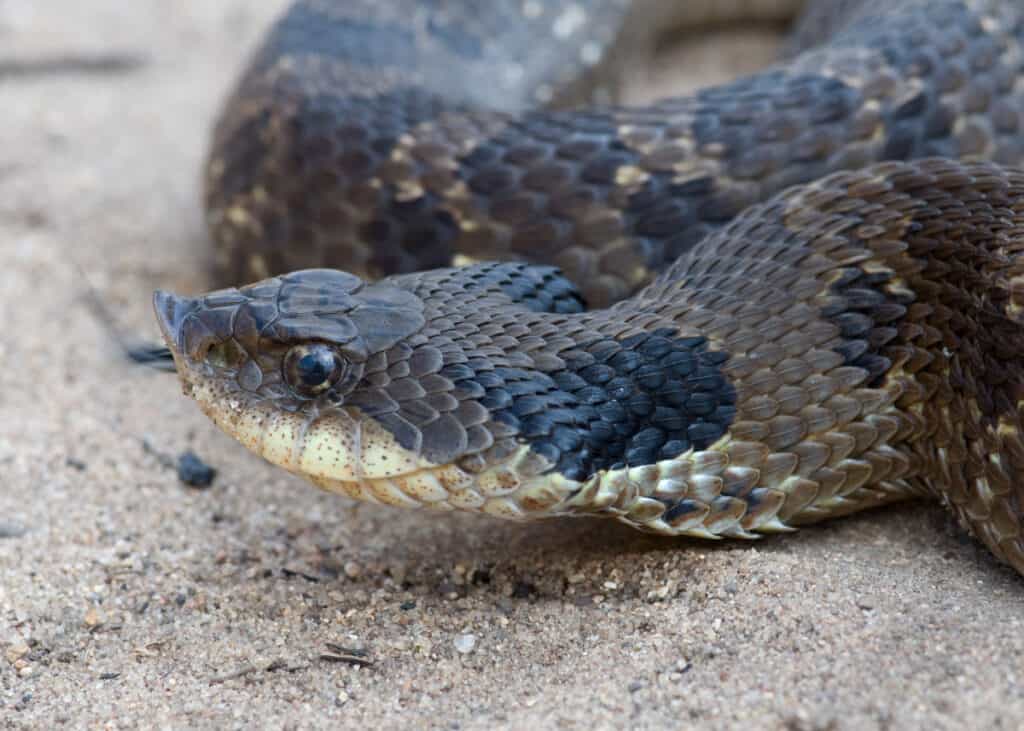
The Eastern Hognose Snake will flatten its head and neck and hiss loudly when threatened.
©Gerald A. DeBoer/Shutterstock.com
| Eastern Hognose Snake | |
|---|---|
| Range | All of Louisiana except for in the southeast |
| Length | 25-33 inches |
The Eastern Hognose Snake lives all throughout Louisiana, except in the southeastern regions of the state. Although these snakes have a large range, they are quite rare. Eastern hognose snakes are light brown, tan, or gray, with black and brown spots and blotches along the length of their bodies. In Louisiana, there are also some with black and red patterns on their sides and bellies as well. These snakes are called “hognose” snakes because of their slightly upturned snouts that resemble a pig’s nose. The eastern hognose snake has a rather unique defense. It dramatically rolls around onto its back, playing dead until the threat has passed.
Louisiana Pine Snake
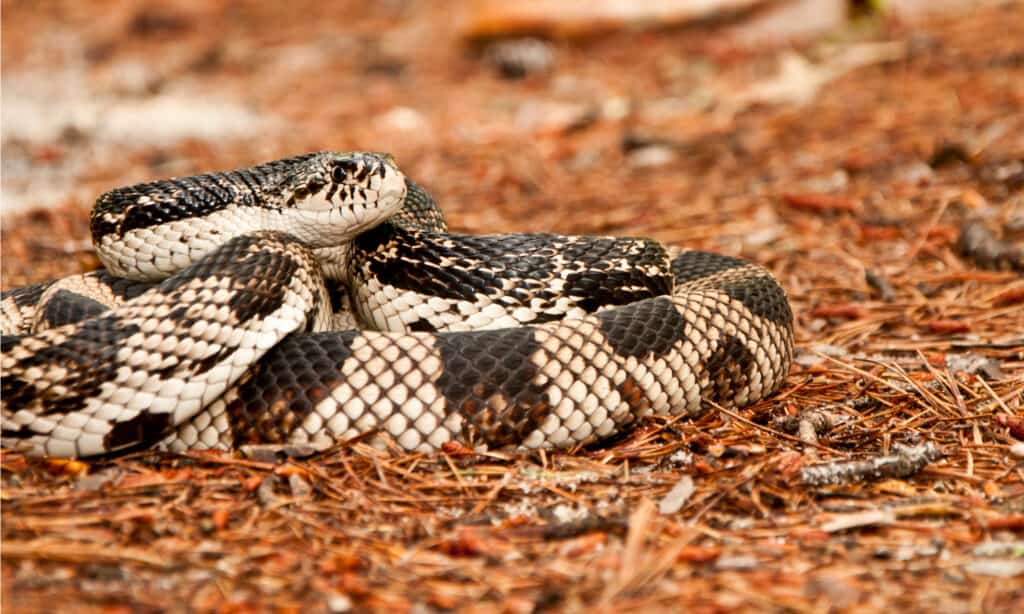
The Louisiana Pine Snake can hiss very loudly due to a small flap near its windpipe.
©Jay Ondreicka/Shutterstock.com
| Louisiana Pine Snake | |
|---|---|
| Range | West of the Mississippi River in Louisiana |
| Length | 48-59 inches |
The Louisiana Pine Snake is a nonvenomous constrictor that only lives west of the Mississippi River in Louisiana, as well as in some regions of eastern Texas. However, this snake is rarely observed in the wild and is one of the rarest snakes in North America. Like its name, the Louisiana pine snake is often found in pine forests and longleaf pine savannahs. These snakes spend much of their lives underground in pocket gopher burrows, where they prey on the small resident rodents. Louisiana pine snakes have a pale-yellow base color, with darkly outlined brown splotches along the length of their bodies. These squarish-shaped blotches are close together near the snake’s head but progressively spread out as they near the snake’s tail. The Louisiana pine snake is an endangered species and is protected by state laws in Louisiana.
Speckled Kingsnake
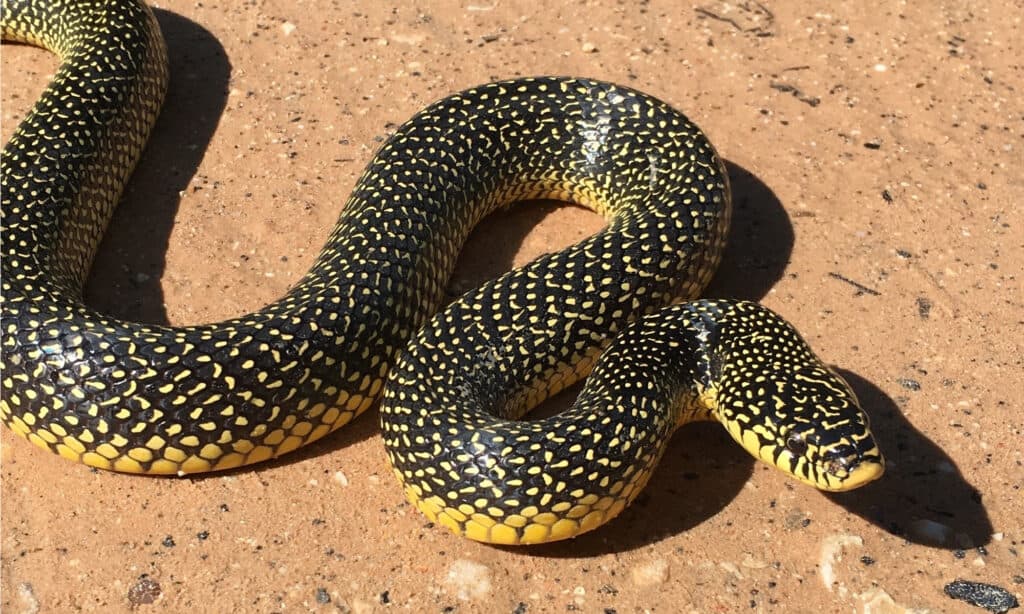
The
Speckled Kingsnake
is a subspecies of the Common Kingsnake.
©Joe Farah/Shutterstock.com
| Speckled Kingsnake | |
|---|---|
| Range | Western half of Louisiana |
| Length | 36-48 inches |
The Speckled Kingsnake lives in the western half of Louisiana, commonly in moist and damp areas. These snakes are constrictors. They eat small mammals, as well as other snakes. Speckled kingsnakes are typically black with abundant yellow or white spots speckled along their smooth bodies. In certain areas, some of these tiny spots will come together and form very thin bands along with the speckled patterns. Because of their coloring and design, speckled kingsnakes are also called “Salt and Pepper Snakes.”
Banded Water Snake

Due to their color variations and wide flat heads, banded water snakes are often mistaken for venomous snakes.
©iStock.com/passion4nature
| Banded Water Snake | |
|---|---|
| Range | All of Louisiana |
| Length | 24-42 inches |
The Banded Water Snake, also known as the Southern Water Snake, lives all throughout Louisiana. These snakes are found in and near bodies of water, like rivers, lakes, swamps, and marshes, where they prefer to eat fish and frogs. Banded water snakes are 24-42 inches long and can vary greatly in color. However, they are often yellow, red brown, and brown. Their backs are patterned with large blotches and bands running along the length of their bodies. These markings often bleed together and make the snake appear quite darker in color. Some may look almost completely black, while others are gray or brown. Their bellies, on the other hand, are brightly colored with yellow, orange, and red patterns. Due to their color variations and wide flat heads, banded water snakes are often mistaken for venomous snakes, like copperheads and cottonmouth snakes.
Is It Normal to Get Bitten By a Rattlesnake in Louisiana?
Snake bites in Louisiana are relatively rare, at one out of every 37,000 people. Of these bites, only one in 50 million perish from them. The most dangerous snake in Louisiana is the eastern diamondback rattlesnake and most emergency rooms are stocked with the snake’s antivenin.

Eastern diamondbacks are born with a buttonlike appendage at the end of their tails before their recognizable rattle develops.
©Chase D’animulls/Shutterstock.com
Rattlesnake Habitat
Louisiana’s diverse array of natural biomes gives rattlesnakes many places to call their home, including the swamp, grassland, and forest. Rattlesnakes are endothermic, or cold-blooded, so they need to move from shady to sunny areas depending on their body’s temperature. During the wintertime, they do not go into full hibernation, but they still greatly reduce their activities in an effort to conserve as much energy as possible.
Rattlesnakes are also incredible swimmers and are known to frequent Louisiana’s waterways. They swim with their heads held above the water and can reach speeds of up to 18 mph.

This rattlesnake is showcasing its phenomenal swimming ability.
©Tim Malek/Shutterstock.com
How Long Do Rattlesnakes Live?
A typical rattlesnake lives about 10-25 years in the wild depending on the species. Since rattlesnakes are ovoviviparous, they don’t lay eggs like most reptiles. Instead, the mother snake carries the eggs for about three months before giving live birth to a litter of 1-20 babies.
Many young rattlesnakes do not survive their first winter, but if they do they will emerge with a freshly shed skin and the first notch on their rattle. Every time a rattlesnake sheds their skin a new notch is added, meaning the larger the rattle, the older the snake.
Summary of the 3 Rattlesnakes in Louisiana
| Number | Snake | Length | Lifespan | |
|---|---|---|---|---|
| 1 | Timber Rattlesnake | 36-60 inches | 30+ years | All of Louisiana |
| 2 | Western Pygmy Rattlesnake | 16-25 inches | 20+ years | Western Louisiana |
| 3 | Eastern Diamondback Rattlesnake | 36-72 inches | 15-20 years | Southeastern Louisiana |
The photo featured at the top of this post is ©
Discover the "Monster" Snake 5X Bigger than an Anaconda
Every day A-Z Animals sends out some of the most incredible facts in the world from our free newsletter. Want to discover the 10 most beautiful snakes in the world, a "snake island" where you're never more than 3 feet from danger, or a "monster" snake 5X larger than an anaconda? Then sign up right now and you'll start receiving our daily newsletter absolutely free.
Thank you for reading! Have some feedback for us? Contact the AZ Animals editorial team.






